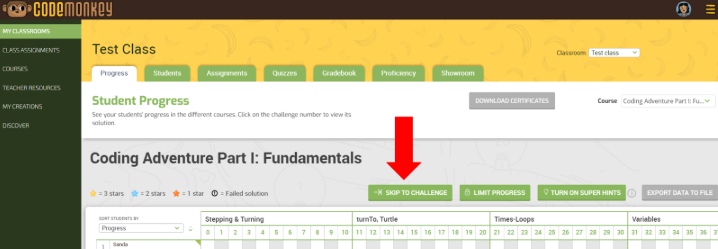Are you looking for fun, free unplugged coding activities and games that you can do with your class? If so, CodeMonkey has you covered in its coding unplugged series. Best of all, you don’t need any programming experience to carry-out these activities – simply choose which coding concept you would like to teach, read the activity over and then do it tomorrow in class. In true offline form, there are no computers or Internet required!
The list below contains all of our offline coding lessons for you to use in your classroom. You can use them as a stand alone activity or combine them with your current computer science curricula on related concepts. We recommended using these games with 3rd-8th graders.
Offline Coding Lessons:
- Sequences – coming soon
- Objects – coming soon
- Loops
- Variables
- Array indexing – coming soon
- For loops – coming soon
- Functions – coming soon
- Until loops
- If else conditionals – coming soon
- Boolean operators – coming soon
- Not – coming soon
- Comparisons – coming soon
- Event handlers
What is unplugged coding?
Unplugged coding aims to teach programming concepts through the use of games or activities that can be done offline using tangible objects, such as paper and markers. Offline coding is a good way to engage younger students without the use of technology. It helps students better understand computer science concepts through role-playing, analogies and other visual exercises.
Offline coding first came about in the early 1990s as an engaging way to communicate programming concepts. Back then it was mainly used as an outreach tool, which provided a good opportunity to cover topics in a short amount of time. It was only afterwards that it turned into a tool used for teacher training. Most recently it has entered the classroom to supplement teacher lessons.
CS Unplugged Key Principles:
- No computers required
- Real computer science
- Learning by doing
- Fun activities
Why should I go offline with my classroom?
Unplugged coding activities come in handy when you want students to visualize a certain programming concept that they have been struggling with. They are relatively easy to carry out and work wonders with helping students collaborate and develop computational and algorithmic thinking skills.
Since unplugged activities work well anywhere, you can take your class outside and carry out the activity there as they explore their surroundings. Offline activities are also great if you have limited access to a computer lab, are having technical problems or are short on time.
Another reason to implement unplugged coding activities is to get every one of your students involved. Since these activities are gender neutral, straightforward and engaging, they do wonders at getting girls, special needs students and those with disabilities quickly involved in the subject. Besides, what better way to learn about user input and output than by playing a fun guessing game? Teachers who have used such coding activities found that it made students more curious and eager to learn coding. Additionally, it was easily implemented across different age groups.
How do I teach Computer Science Unplugged?
First, decide which concept you would like to cover with your class. If it’s the beginning of the year, it might be a good idea to re-introduce a topic to your class with an activity on it. If you are ready for a more advanced topic, proceed to a concept near the end of the list (which is in order of difficulty). Once you have chosen the activity, read it through and collect the items it calls for. Some require index cards or cups with different-colored beverages so it is important to prepare for these ahead of time. Once you have organized all of the items, you are ready to start the activity.
Each activity takes between 15-20 minutes to complete. All of the above unplugged coding games were taken from CodeMonkey’s lesson plans, which are available with the purchase of a full teacher subscription. If you have a teacher subscription and would like the full lesson, you can download it on the teacher resources menu on the right hand side of your homepage.
A great way to teach unplugged coding is through CodeMonkey. Each course comes equipped with step-by-step lesson plans, beginning with an introduction, an unplugged classroom activity and/or screen time for real coding, followed by a debriefing. In a total of 45 minutes you can help your students to truly understand a coding concept and feel ready to take it on by writing real code.
The added value and benefits that unplugged coding activities bring to students are plentiful. They offer an engaging activity that helps to instill computational thinking in students. It takes learning computer programming from an independent task to a group one. Make your next class more exciting by introducing one of the games mentioned above and help your students explore CS in a new and meaningful way.





2 Replies to “Unplugged Coding Activities You Can Do with Your Students”
THIS SEEMS LIKE SO MUCH FUN!!!!
The best “unplugged” activite that help with coding learning, is to creating and solving algorithms. There is one, very old game, which perfectly develop creative and strategic thinking – chess. I rediscovered it advantages in learning about algorithm. I’m learning computer science to kids at primary school, so I can recommend this book – net-bossorg/chess-puzzles-for-kids-by-maksim-aksanov which contains a series of diagrams with problem to solve like capturing a piece with only one move, check and checkmate situations with limited numbers of move or strategies like fork etc.